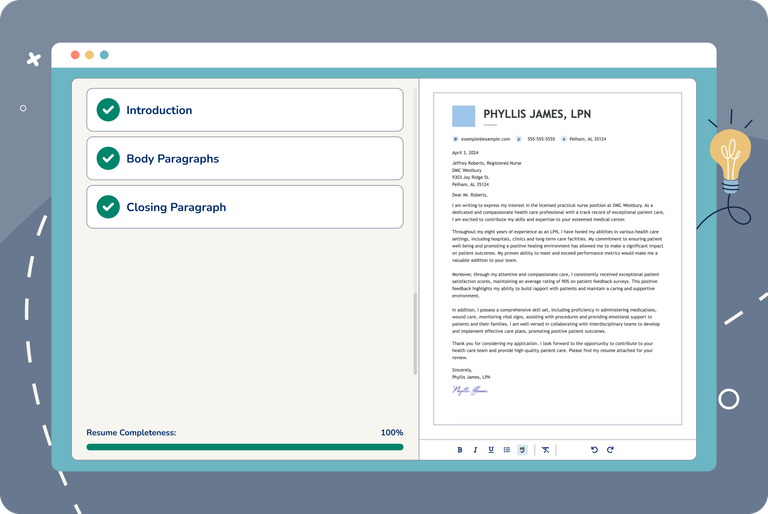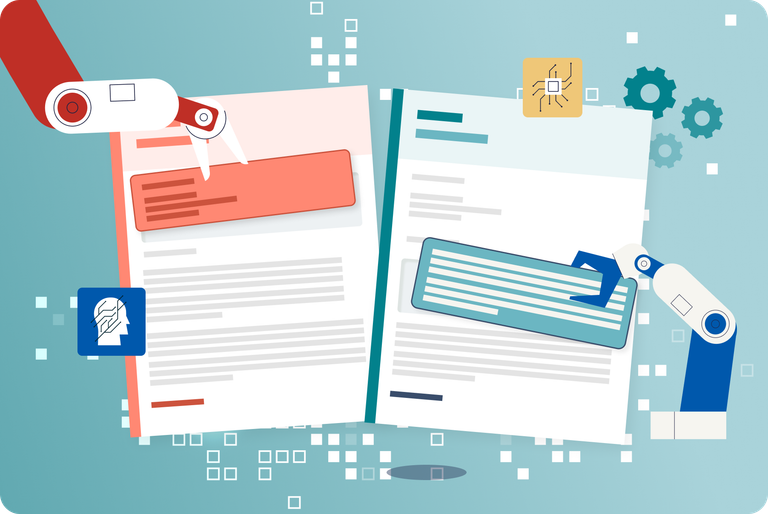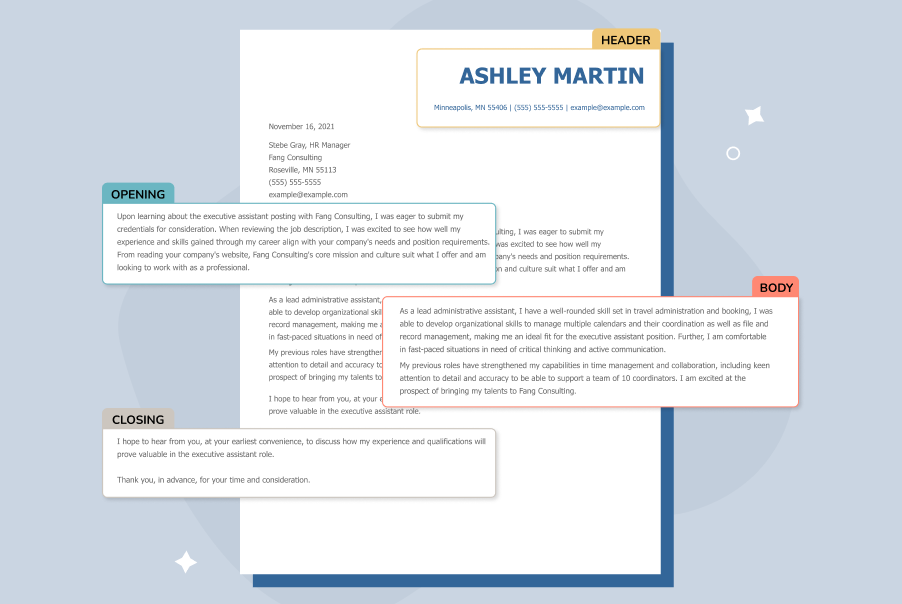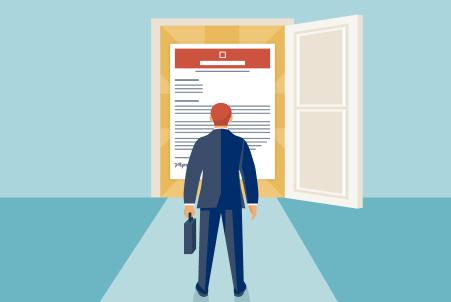Our customers have been hired at: *Foot Note
Knowing how long a cover letter should be is essential for crafting a job application that engages hiring managers and showcases your unique fit for the role.
In this guide, we’ll explore expert insights, industry standards, and key strategies for achieving the ideal cover letter length. Reference the guidelines below to start crafting your cover letter:
- Page count: 0.5 – 1 page document
- Word count: 250 – 400 words
- Paragraph count: 3 – 6 paragraphs
How Long Should a Cover Letter Be for a Job?
Your cover letter should be half a page to one full page long, generally 250-400 words and three to six paragraphs. Explore our cover letter format guide for additional tips and best practices.
Based on a review of over 540,000 cover letters created on MyPerfectResume between Jan. 1, 2024, and Aug. 12, 2024, the median cover letter word count is 224, and the median character count is 1,531. The top 25% of longest letters are over 394 words and 2,778 characters.
In order to keep your cover letter concise, you want to focus on the most relevant and impactful information and tailor your letter to each specific job. Limiting your cover letter to just one page demonstrates that you respect the reader's time and also increases the likelihood that they will read your letter in its entirety.- Jasmine Escalera, Career Professional
You can use our Cover Letter Generator to easily craft a one-page cover letter with professionally written content suggestions tailored to your skills and experience.
Ideal Cover Letter Length Examples
A concise yet comprehensive cover letter is essential for capturing the attention of recruiters and hiring managers. Here is a well-measured teacher cover letter example:
Tailor your cover letter to the specific role or opportunity you are applying for. For instance, this internship cover letter focuses on academic achievements and previous internship experience:
What to Include in a One-Page Cover Letter
We’ve detailed the key sections of a one-page cover letter below. See what to include in a cover letter for additional guidance:
Header
Your cover letter header should include your name, contact information (phone, email), and the date, followed by the employer’s details (hiring manager’s name, company, and address).
To save space, use a single line for your contact information and avoid unnecessary details such as your full address unless required for the role.
A clean, concise header ensures more room for your cover letter content while maintaining a polished look that impresses employers.
Intro paragraph
Begin the first paragraph of your cover letter with a strong opening line that captures the reader’s attention. Here are a few examples:
- Highlighting specific achievements: “After leading my team at Dell Technologies to a 25% increase in efficiency through innovative workflow redesigns, I am excited to bring my technical project management skills to the project manager role at Google.”
- Expressing passion for the field: “My passion for renewable energy solutions and my experience in developing solar panel technologies at SunPower make me an ideal candidate for the energy solutions specialist position at Tesla.”
- Connecting past experience to the new role: “Having successfully managed over $10 million in client portfolios at Morgan Stanley, I am ready to leverage my expertise in high-stakes financial environments as a senior financial analyst at Goldman Sachs.”
Explore how to write a cover letter for step-by-step guidance on crafting a compelling introduction that immediately grabs the attention of potential employers.
Body paragraphs
The body paragraphs of your cover letter should expand upon your resume skills and showcase how your competencies align with the job description.
Provide specific examples of achievements and experiences that demonstrate your ability to succeed in the role you are applying for.
Whenever possible, quantify your accomplishments using numbers or statistics. You can use bullet points to save space and call attention to your achievements, for example:
Closing paragraph
Conclude by reiterating your interest in the position and thanking the hiring manager for considering your application. For example:
“Thank you for considering my candidacy for the marketing manager position at Innovatech. I am enthusiastic about the opportunity to bring my unique expertise in digital marketing and brand strategy to your team. I am eager to discuss how I can contribute to your company's success and look forward to the possibility of working together. Please feel free to contact me at your convenience to schedule an interview.”
Tips for Achieving the Ideal Cover Letter Length
In many cases, a basic cover letter is more impactful than a lengthy one. Browse expert tips on crafting a concise cover letter that gets noticed by hiring managers.
Tip #1: Refer to the job description
It's important to check the job description for any specific instructions regarding the cover letter you send with your application.
Employers might specify what they want you to include, such as particular skills or experiences, how they want the cover letter formatted or any particular questions they want you to answer.
Following these instructions carefully can help you tailor your resume and your cover letter to the job and increase your chances of making a good impression.
Highlight the most relevant skills and experiences that align with the job description. This targeted approach prevents you from including unnecessary or generic information.
Tip #2: Focus on key accomplishments
Rather than detailing your entire job history, focus on one or two key achievements that demonstrate your qualifications for the position.
Provide specific examples that show how you've successfully handled relevant responsibilities. Expand upon achievements from your resume or offer new examples to avoid repeating yourself.
Career professional Toni Frana advises that your cover letter should "illustrate a few key accomplishments and results as they relate to the position you are applying for."
Think of your cover letter as a tool to complement your resume and to share a bit more about your career story. This helps connect the dots for the employer and allows them to start to visualize you in the role.
- Toni Frana, Career Professional
Tip #3: Leverage formatting best practices
Below are a few formatting tips for creating a professional cover letter that fits comfortably on a single page and effectively captures the attention of hiring managers.
- Font style and size: Choose a professional font such as Arial, Calibri, or Times New Roman. Keep the font size between 10.5 and 12 points for the body text.
- Margins: Set your margins to at least 0.5 inches on all sides, but no more than 1 inch. Slightly tighter margins can help conserve space without overcrowding the page.
- Line spacing: Use 1.0 or 1.15 line spacing. This helps maintain readability without taking up too much space.
- White space: White space around headers, paragraphs, and sections makes your cover letter easier to read.
- Paragraph length: Keep paragraphs short and to the point, ideally 3-4 lines each. This helps maintain a clean look and makes the cover letter easier to skim.
- Bullet points: Consider using 3-5 bullet points to succinctly list your qualifications or achievements. This can help break up the text and make your key points stand out.
- Consistent style: Use the same style for bullets, headers, and fonts throughout your document. Consistency helps maintain a professional appearance.
Tip #4: Use concise language
Use straightforward and direct language to ensure that every sentence conveys meaningful information about your qualifications and fit for the role.
This approach helps keep the reader’s attention focused on your strengths and achievements without distracting them with unnecessary details.
Aim to be succinct and to the point, using action verbs and specific examples that directly relate to the job you're applying for.
This not only makes your cover letter easier to read but also demonstrates your ability to communicate efficiently — a valuable skill in any professional setting.
Browse our library of cover letter examples to see the average cover letter length for various roles, industries, and career stages.
Tip #5: Edit and revise
Start by reading through your current draft. Look for any redundant phrases or overly complex sentences that can be simplified. Aim to express your ideas as clearly and directly as possible.
Identify the most important points that directly align with the job description. Make sure these are highlighted effectively in your cover letter and remove or condense less relevant information.
Remove unnecessary qualifiers like “very,” “quite,” “actually,” “basically,” and “really.” These words add length without value and can make your writing seem less confident.
Cover Letter Length Mistakes to Avoid
When crafting a cover letter, certain missteps related to length can undermine your application. Below are some common length-related mistakes to avoid.
Mistake #1: Including irrelevant details
Explaining every aspect of your career can lead to a lengthy and unfocused cover letter. Stick to details that are pertinent to the job and highlight your qualifications.
Identify the most important points that directly align with the job description. Ensure these are highlighted effectively in your cover letter and remove irrelevant information.
Explore our ChatGPT cover letter guide for actionable tips on using AI to support the cover letter writing process.
Mistake #2: Repeating your resume
A common mistake is to simply restate what's already in your resume, which can lead to unnecessary length and redundancy.
Career professional Jasmine Escalera says, "Use this document as an opportunity to enhance your story, show your personality, and elaborate on select experiences that align with the job you're applying for."
Keep your cover letter to one page by understanding that it's meant to complement, not replicate, your resume. By focusing on adding value and context rather than repeating information, you’ll capture the employer's interest and keep the document concise.
- Jasmine Escalera, PhD, Career Professional
Mistake #3: Suboptimal formatting
Disorganized content can make your cover letter appear longer than it actually is and make it difficult for the reader to identify the key takeaways.
Use a clear structure with headings, bullet points, and short paragraphs to improve readability and conciseness.
Use a professionally crafted cover letter template to take the guesswork out of formatting your document.
Key Takeaways
- Your cover letter should be half a page to one page long and should follow the business letter format. Always tailor your cover letter to match the specific job description.
- Your cover letter word count should be around 250-400, but remember that your primary focus should be the content and formatting of your document.
- Explain why you are the best candidate and express your interest in the company in three to six concise paragraphs. Use bullet points to highlight key information.
FAQ
How long does a cover letter have to be?
A cover letter should typically be one page long, consisting of about three to six paragraphs (four paragraphs is an ideal length to aim for).
This length allows you to concisely convey your interest in the position, summarize your most relevant qualifications, and explain why you would be a good fit for the role.
Keeping it to one page ensures that you remain focused on the key points without overwhelming the reader with too much information.
How many words should a cover letter be?
A cover letter should typically be between 250 to 400 words. This length is sufficient to introduce yourself while keeping the content concise and engaging.
This cover letter word count helps ensure that your cover letter remains focused and can be quickly read by hiring managers, who often have limited time to review each application.
Briefly explain why you are interested in the job and the company, highlight a few key achievements or experiences, and conclude with a call to action.
See the qualities of successful cover letters for additional details about what to include in your letter to stand out to hiring managers.
Is a 500-word cover letter too long?
A 500-word cover letter is on the longer side, especially considering that the ideal length is typically around 250 to 400 words.
While it’s not excessively long, you should ensure that every word adds value and relevance to your application.
We recommend using an AI cover letter generator to quickly and easily craft a compelling cover letter that does not exceed one page.
Can a cover letter be two pages?
Two pages is generally too long for a cover letter. Most employers prefer cover letters to be concise — usually about one page or 250 to 400 words.
Keeping your cover letter to one page helps maintain the reader’s attention and shows that you can communicate your points effectively and efficiently.
We also recommend exploring answers to the question, “Are cover letters necessary?” for additional guidance from career advice experts.
Is a 200-word cover letter too short?
While brevity is appreciated, an overly concise cover letter may not provide enough space to effectively highlight your relevant skills and express your interest in the position.
However, a 200-word cover letter might be perfectly adequate for certain situations. A shorter cover letter can be effective for entry-level candidates or those with limited experience.
Additionally, when applying for roles in industries that value brevity and clarity (like certain tech startups), a 200-word cover letter could strike the right tone and fit the expected format.
What if my cover letter is too long?
If your cover letter is too long, consider taking the following steps to refine and shorten it, ensuring it stays focused and impactful:
- Prioritize key points: Remove any details that do not directly align with the job requirements.
- Eliminate redundancies: Check for repetitive information or over-explained points. Condense where possible without losing the necessary detail.
- Use concise language: Replace verbose phrases with more straightforward language. Avoid filler words and unnecessary adjectives to make each sentence more potent.
- Shorten the introduction and conclusion: Your introduction should quickly grab attention, and your conclusion should succinctly encourage further action.
By refining your cover letter in these ways, you can keep it within the ideal length while ensuring it effectively communicates why you are the right candidate for the job.
How long should a cover letter be for an internship?
A cover letter for an internship should be up to one page long, which generally translates to between 250 and 400 words.
This length lets you articulate your interest in the internship, explain why you’re a good fit, and highlight relevant coursework or projects without overwhelming the reader.
Keeping your cover letter concise is crucial, as it shows you can communicate effectively and respect the reader’s time.
Should a cover letter be one page for every job?
A cover letter should generally be one page for almost every job. Hiring managers prefer concise, focused letters highlighting relevant skills and experiences without unnecessary details.
How we reviewed this article
Since 2012, we have helped more than 11 million job seekers. We want to make your career journey accessible and manageable through our services and Career Center’s how-to guides and tips. In our commitment to bring you a transparent process, we present our Editorial Process.
Our customers have been hired at:*Foot Note









